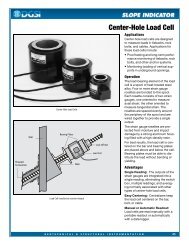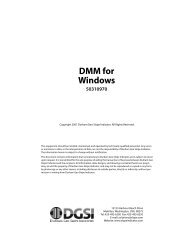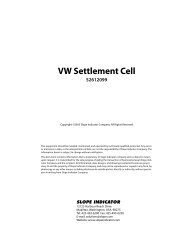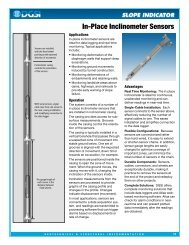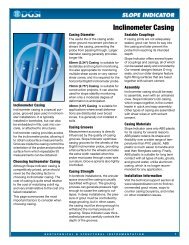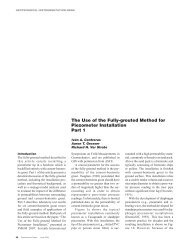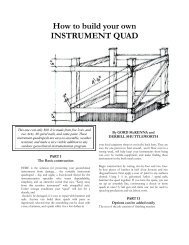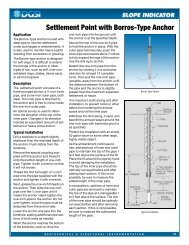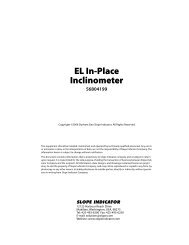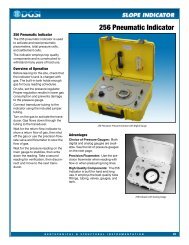Piezometers in Fully Grouted Boreholes
Piezometers in Fully Grouted Boreholes
Piezometers in Fully Grouted Boreholes
Create successful ePaper yourself
Turn your PDF publications into a flip-book with our unique Google optimized e-Paper software.
are mixed first, the water-cement ratio stays fixed and the strength/modulus of the set grout ismore predictable. If bentonite slurry is mixed first, the water-cement ratio cannot be controlledbecause the addition of cement must stop when the slurry thickens to a consistency that is stillpumpable.Mak<strong>in</strong>g cement-bentonite grout <strong>in</strong> the field is a straightforward process. The most effectivemix<strong>in</strong>g is commonly done <strong>in</strong> a barrel or tub with the drill-rig pump, circulat<strong>in</strong>g the batchthrough the pump <strong>in</strong> 50 to 200 gallon quantities. The rig pump provides the k<strong>in</strong>d of jet-mix<strong>in</strong>grequired to get the job done quickly. Any k<strong>in</strong>d of bentonite powder used to make drill<strong>in</strong>g mudcomb<strong>in</strong>ed with Type 1 or 2 Portland cement and water can be used, but the appropriate quantityof bentonite will vary somewhat depend<strong>in</strong>g on grade of bentonite, mix<strong>in</strong>g sequence, mix<strong>in</strong>g effort(agitation), water pH and temperature.Grout mixes should be controlled by weight and proportioned to give the desired strength ofthe set grout. The conversion factors conta<strong>in</strong>ed <strong>in</strong> Appendix H.10 <strong>in</strong> Dunnicliff (1988, 1993)are very helpful <strong>in</strong> mix design. Two mixes are given <strong>in</strong> Table 1 that varies <strong>in</strong> 28-day strengthfrom 50 psi to 4 psi for water-cement ratios of 2.5 to 6.6 respectively.Table 1. Cement-bentonite grout, water and cement mixed first.Application Grout for Medium to Hard Soils Grout for Soft SoilsMaterials Weight Ratio by Weight Weight Ratio by WeightWater 30 gallons 2.5 75 gallons 6.6Portland94 lbs.94 lbs.1Cement( 1 sack)( 1 sack)1Bentonite25 lbs.39 lbs.0.3(as required)(as required)0.4NotesThe 28-day compressive strength of this mix isabout 50 psi, similar to very stiff to hard clay. Themodulus is about 10,000 psi.The 28-day strength of this mix is about 4 psi,similar to very soft clay.3.4 Example mix<strong>in</strong>g procedure.A rig pump with one suction hose and a return hose fitted with a jet nozzle <strong>in</strong> a 50-gallon barrelare the m<strong>in</strong>imum requirements for circulation batch mix<strong>in</strong>g of grout. Paddle or high shear mixerscan also be used. A measured quantity of clean water goes <strong>in</strong>to the mix<strong>in</strong>g tub/barrel firstand pump<strong>in</strong>g and circulation starts. Then the cement is gradually added to the water and mixedthoroughly. At this stage the mix is like gray water. Next, bentonite powder is slowly added <strong>in</strong>tothe jett<strong>in</strong>g area of the barrel, slowly enough so clumps of bentonite do not form. This should beconstantly checked by scrap<strong>in</strong>g the bottom with a shovel. When clumps form, slow down and donot add any more powder until they are dissolved. Keep add<strong>in</strong>g bentonite until the watery mixtransitions to an oily/slimy consistency. Observe the consistency while mix<strong>in</strong>g and let the groutthicken for another five to ten m<strong>in</strong>utes. Generally, the mix thickens some more with addedmix<strong>in</strong>g time. Add more bentonite as required. When it is smooth and like thick cream or pancakebatter, it is as heavy as is it feasible to pump. Drips of the grout should then barely comeoff a dipped f<strong>in</strong>ger and form “craters” <strong>in</strong> the fluid surface. That is the correct consistency forpump<strong>in</strong>g the grout batch down the tremie-pipe. When possible, withdraw the tremie after eachbatch an amount correspond<strong>in</strong>g to the grout level <strong>in</strong> the bor<strong>in</strong>g to keep the pump<strong>in</strong>g pressures aslow as possible. When pump<strong>in</strong>g grout 100 feet or more from the borehole, th<strong>in</strong>ner consistencywould be required, but at the risk of some bleed<strong>in</strong>g.Old habits die hard, so that some users will <strong>in</strong>sist on mix<strong>in</strong>g water and bentonite powder firstas recommended by Dunnicliff (1988, 1993). This practice should be abandoned for <strong>in</strong>strumentgrouts. This is normally the way drill<strong>in</strong>g mud is mixed and it yields more slurry per sack ofbentonite than the above method. Also, use of hydrated bentonite with cement added last iscommon practice <strong>in</strong> grout<strong>in</strong>g technology for ground improvement. Such mixes are highly thixo5



